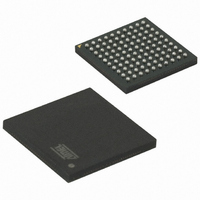ATSAM3U4CA-CU Atmel, ATSAM3U4CA-CU Datasheet - Page 56

ATSAM3U4CA-CU
Manufacturer Part Number
ATSAM3U4CA-CU
Description
IC MCU 32BIT 256KB FLSH 100TFBGA
Manufacturer
Atmel
Series
SAM3Ur
Specifications of ATSAM3U4CA-CU
Core Processor
ARM® Cortex-M3™
Core Size
32-Bit
Speed
96MHz
Connectivity
EBI/EMI, I²C, MMC, SPI, SSC, UART/USART, USB
Peripherals
Brown-out Detect/Reset, DMA, I²S, POR, PWM, WDT
Number Of I /o
57
Program Memory Size
256KB (256K x 8)
Program Memory Type
FLASH
Ram Size
52K x 8
Voltage - Supply (vcc/vdd)
1.65 V ~ 1.95 V
Data Converters
A/D 4x10b, 4x12b
Oscillator Type
Internal
Operating Temperature
-40°C ~ 85°C
Package / Case
100-TFBGA
Processor Series
ATSAM3x
Core
ARM Cortex M3
Data Bus Width
32 bit
Data Ram Size
52 KB
Interface Type
3xUSART, TWI, 4xSPI, Bus
Maximum Clock Frequency
96 MHz
Number Of Programmable I/os
57
Number Of Timers
8
Operating Supply Voltage
1.62 V to 3.6 V
Maximum Operating Temperature
+ 85 C
Mounting Style
SMD/SMT
3rd Party Development Tools
JTRACE-CM3, MDK-ARM, RL-ARM, ULINK2
Development Tools By Supplier
ATSAM3U-EK
Minimum Operating Temperature
- 40 C
Lead Free Status / RoHS Status
Lead free / RoHS Compliant
Eeprom Size
-
Lead Free Status / Rohs Status
Lead free / RoHS Compliant
Available stocks
Company
Part Number
Manufacturer
Quantity
Price
Part Number:
ATSAM3U4CA-CU
Manufacturer:
ATMEL/爱特梅尔
Quantity:
20 000
- Current page: 56 of 1171
- Download datasheet (25Mb)
13.2.1
13.2.2
13.2.3
56
SAM3U Series
System level interface
Integrated configurable debug
Cortex-M3 processor features and benefits summary
mized design, providing high-end processing hardware including single-cycle 32x32
multiplication and dedicated hardware division.
To facilitate the design of cost-sensitive devices, the Cortex-M3 processor implements tightly-
coupled system components that reduce processor area while significantly improving interrupt
handling and system debug capabilities. The Cortex-M3 processor implements a version of the
Thumb
The Cortex-M3 instruction set provides the exceptional performance expected of a modern 32-
bit architecture, with the high code density of 8-bit and 16-bit microcontrollers.
The Cortex-M3 processor closely integrates a configurable nested interrupt controller (NVIC), to
deliver industry-leading interrupt performance. The NVIC provides up to 16 interrupt priority lev-
els. The tight integration of the processor core and NVIC provides fast execution of interrupt
service routines (ISRs), dramatically reducing the interrupt latency. This is achieved through the
hardware stacking of registers, and the ability to suspend load-multiple and store-multiple opera-
tions. Interrupt handlers do not require any assembler stubs, removing any code overhead from
the ISRs. Tail-chaining optimization also significantly reduces the overhead when switching from
one ISR to another.
To optimize low-power designs, the NVIC integrates with the sleep modes, that include a deep
sleep function that enables the entire device to be rapidly powered down.
The Cortex-M3 processor provides multiple interfaces using AMBA
speed, low latency memory accesses. It supports unaligned data accesses and implements
atomic bit manipulation that enables faster peripheral controls, system spinlocks and thread-safe
Boolean data handling.
The Cortex-M3 processor has a memory protection unit (MPU) that provides fine grain memory
control, enabling applications to implement security privilege levels, separating code, data and
stack on a task-by-task basis. Such requirements are becoming critical in many embedded
applications.
The Cortex-M3 processor implements a complete hardware debug solution. This provides high
system visibility of the processor and memory through either a traditional JTAG port or a 2-pin
Serial Wire Debug (SWD) port that is ideal for microcontrollers and other small package devices.
For system trace the processor integrates an Instrumentation Trace Macrocell (ITM) alongside
data watchpoints and a profiling unit. To enable simple and cost-effective profiling of the system
events these generate, a Serial Wire Viewer (SWV) can export a stream of software-generated
messages, data trace, and profiling information through a single pin.
• tight integration of system peripherals reduces area and development costs
• Thumb instruction set combines high code density with 32-bit performance
• code-patch ability for ROM system updates
• power control optimization of system components
• integrated sleep modes for low power consumption
• fast code execution permits slower processor clock or increases sleep mode time
• hardware division and fast multiplier
®
instruction set, ensuring high code density and reduced program memory requirements.
®
technology to provide high
6430D–ATARM–25-Mar-11
Related parts for ATSAM3U4CA-CU
Image
Part Number
Description
Manufacturer
Datasheet
Request
R

Part Number:
Description:
KIT EVAL FOR AT91SAM3U CORTEX
Manufacturer:
Atmel
Datasheet:

Part Number:
Description:
AT91 ARM Thumb-based Microcontrollers
Manufacturer:
ATMEL [ATMEL Corporation]
Datasheet:

Part Number:
Description:
DEV KIT FOR AVR/AVR32
Manufacturer:
Atmel
Datasheet:

Part Number:
Description:
INTERVAL AND WIPE/WASH WIPER CONTROL IC WITH DELAY
Manufacturer:
ATMEL Corporation
Datasheet:

Part Number:
Description:
Low-Voltage Voice-Switched IC for Hands-Free Operation
Manufacturer:
ATMEL Corporation
Datasheet:

Part Number:
Description:
MONOLITHIC INTEGRATED FEATUREPHONE CIRCUIT
Manufacturer:
ATMEL Corporation
Datasheet:

Part Number:
Description:
AM-FM Receiver IC U4255BM-M
Manufacturer:
ATMEL Corporation
Datasheet:

Part Number:
Description:
Monolithic Integrated Feature Phone Circuit
Manufacturer:
ATMEL Corporation
Datasheet:

Part Number:
Description:
Multistandard Video-IF and Quasi Parallel Sound Processing
Manufacturer:
ATMEL Corporation
Datasheet:

Part Number:
Description:
High-performance EE PLD
Manufacturer:
ATMEL Corporation
Datasheet:

Part Number:
Description:
8-bit Flash Microcontroller
Manufacturer:
ATMEL Corporation
Datasheet:

Part Number:
Description:
2-Wire Serial EEPROM
Manufacturer:
ATMEL Corporation
Datasheet:











